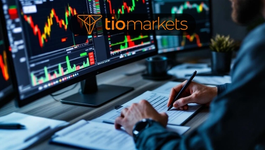The Basics of Trading ETFs
BY TIOmarkets
|May 21, 2024Exchange-traded funds (ETFs) have become increasingly popular in recent years as a preferred investment vehicle for both novice and experienced traders. In this article, we will explore the fundamentals of trading ETFs, including what they are, their structure, various types, benefits, risks, getting started, key strategies, and navigating the ETF market. By understanding these basics, you'll be well-equipped to make informed investment decisions in the exciting world of ETF trading.
Understanding ETFs: An Overview
Let's begin by gaining a clear understanding of what ETFs are. Essentially, ETFs are investment funds that trade on stock exchanges, just like individual stocks. They are designed to track a specific index, commodity, sector, or asset class. Unlike mutual funds, which are priced based on the net asset value at the end of the trading day, ETFs are priced throughout the trading day, allowing for real-time trading.
What are ETFs?
An ETF is a basket of securities, which can include stocks, bonds, commodities, or a mix of asset classes. It offers investors exposure to the performance of the underlying index or asset without having to buy each individual security. This diversification helps spread the risk and can be an efficient way to gain exposure to a particular market or sector.
The Structure of ETFs
ETFs are structured in a unique way that allows them to combine the benefits of both open-end mutual funds and individual shares of stock. They are created and managed by asset management companies, known as ETF providers. The shares of an ETF are issued in creation units, which represent the underlying basket of securities. Authorized participants, such as large financial institutions, create or redeem ETF shares in exchange for the underlying basket of securities or cash.
Types of ETFs
There is a wide range of ETFs available to cater to different investment objectives and strategies. Some common types include equity ETFs, bond ETFs, commodity ETFs, sector ETFs, and international ETFs. Each type has its own characteristics and investment focus, allowing investors to tailor their portfolios to their specific goals.
Equity ETFs, for example, provide exposure to a diversified portfolio of stocks. They can be broad-based, tracking a broad market index like the S&P 500, or focused on a specific sector or industry. Bond ETFs, on the other hand, invest in a portfolio of fixed-income securities, such as government bonds or corporate bonds. These ETFs provide investors with a way to gain exposure to the bond market without having to buy individual bonds.
Commodity ETFs are designed to track the performance of commodities like gold, silver, oil, or agricultural products. They offer investors an opportunity to participate in the price movements of these commodities without the need for physical ownership. Sector ETFs focus on specific sectors of the economy, such as technology, healthcare, or energy. These ETFs allow investors to target their investments in industries they believe will outperform the broader market.
International ETFs provide exposure to markets outside of the investor's home country. They can track the performance of specific countries, regions, or even global indices. These ETFs offer diversification benefits and allow investors to participate in the growth of economies around the world.
By offering a wide range of ETFs, the investment industry provides investors with the flexibility to build diversified portfolios that align with their investment goals and risk tolerance. Whether an investor is looking for broad market exposure, specific sector exposure, or international diversification, there is likely an ETF available to meet their needs.
The Benefits and Risks of Trading ETFs
Before diving into ETF trading, it's important to consider their benefits and associated risks, as with any investment.
Exchange-Traded Funds (ETFs) have gained popularity among investors for various reasons. One of the primary advantages of trading ETFs is their diversification benefits. By investing in an ETF, you gain exposure to multiple securities, reducing the risk associated with individual stocks or bonds. This diversification can help spread risk across different asset classes and industries, providing a level of stability to your investment portfolio. Furthermore, ETFs also offer flexibility, as they can be bought or sold throughout the trading day, providing liquidity that is not always available with other investment vehicles.
In addition to diversification and flexibility, ETFs often have lower expense ratios compared to mutual funds, making them cost-effective for investors. This cost efficiency can lead to higher returns for investors in the long run, as lower fees mean more of the investment's returns stay in the investor's pocket. Moreover, ETFs are known for their tax efficiency, as they typically have lower capital gains distributions compared to mutual funds, which can result in tax savings for investors.
Advantages of ETF Trading
One of the primary advantages of trading ETFs is their diversification benefits. By investing in an ETF, you gain exposure to multiple securities, reducing the risk associated with individual stocks or bonds. ETFs also offer flexibility, as they can be bought or sold throughout the trading day, providing liquidity. Additionally, they often have lower expense ratios compared to mutual funds, making them cost-effective for investors.
Despite the numerous advantages of ETF trading, there are potential risks that investors should be aware of. Market volatility is a significant risk, as it can cause the value of the underlying assets in an ETF to fluctuate. This volatility can lead to sudden and unexpected changes in the value of the investment, potentially resulting in losses for investors. Furthermore, some ETFs use derivatives or leverage to amplify returns, which can also amplify losses. It's important for investors to understand the specific strategies employed by an ETF and the associated risks before investing.
Potential Risks in ETF Trading
While ETFs offer numerous advantages, it's crucial to understand the potential risks involved. One risk is market volatility, which can cause the value of the underlying assets to fluctuate. Additionally, some ETFs use derivatives or leverage, which can amplify both gains and losses. Lack of transparency, tracking error, and liquidity risks are also important considerations. It's important to carefully research and assess the risks associated with each ETF before investing.
Getting Started with ETF Trading
Now that you understand the basics and risks of ETFs, let's explore how to get started with trading them.
Choosing the Right ETF
When selecting an ETF, it's crucial to consider your investment objectives and the underlying assets. Assess the fund's performance, expense ratio, tracking error, and liquidity to ensure it aligns with your goals and risk tolerance. Conduct thorough research and seek advice from financial professionals to make an informed decision.
Understanding ETF Pricing
ETF prices are determined by market supply and demand, similar to individual stocks. These prices may deviate from their net asset value due to factors such as trading volume, market sentiment, and liquidity. It's important to monitor and understand the pricing dynamics of the ETFs you wish to trade to optimize your investment strategy.
Key Strategies for ETF Trading
Developing a well-defined trading strategy is vital for success in ETF trading. Let's explore two key strategies: long-term investment and short-term trading.
Long-Term Investment Strategy
A long-term investment strategy involves holding ETFs for an extended period, typically years or even decades. This strategy aims to capitalize on the potential long-term growth of the underlying assets. It requires a patient and disciplined approach, careful asset allocation, and periodic rebalancing to maintain the desired portfolio mix.
Short-Term Trading Strategy
Short-term trading involves taking advantage of short-lived market opportunities to profit from price fluctuations in ETFs. Traders using this strategy actively monitor market trends, technical analysis, and news events to make quick decisions. It requires a thorough understanding of market dynamics and risk management techniques.
Navigating the ETF Market
As you delve deeper into ETF trading, it's essential to navigate the market strategically.
Market Trends and ETFs
Keep a close eye on market trends, as they can significantly impact the performance of different ETFs. Regularly analyze market indicators, economic data, and sector-specific news to identify emerging trends and align your investment strategy accordingly.
ETF Liquidity and Trading Volume
Liquidity is a critical factor when trading ETFs, as it determines how easily you can enter or exit a position. Higher trading volumes and tighter bid-ask spreads are generally indicative of a liquid ETF. Pay attention to these factors to ensure smooth execution of trades and to avoid potential slippage.
By grasping the basics of trading ETFs, understanding their benefits and risks, selecting the right ETFs, utilizing key strategies, and navigating the market effectively, you can set yourself on a path toward successful ETF trading. Remember to stay informed, constantly evaluate your investment approach, and seek professional advice when needed. Happy trading!
Start Trading ETFs with TIOmarkets
Ready to apply the fundamentals of ETF trading to the real market? Join TIOmarkets, the top-rated forex broker, and expand your trading portfolio with over 300 instruments across 5 markets. Benefit from our low fees and robust trading platform, trusted by over 170,000 traders in more than 170 countries. Enhance your trading skills with our comprehensive educational resources and step-by-step guides.
Take the first step towards successful trading by creating a Trading Account today and unlock the potential of ETFs!

Risk disclaimer: CFDs are complex instruments and come with a high risk of losing money rapidly due to leverage. You should consider whether you understand how CFDs work and whether you can afford to take the high risk of losing your money. Never deposit more than you are prepared to lose. Professional client’s losses can exceed their deposit. Please see our risk warning policy and seek independent professional advice if you do not fully understand. This information is not directed or intended for distribution to or use by residents of certain countries/jurisdictions including, but not limited to, USA & OFAC. The Company holds the right to alter the aforementioned list of countries at its own discretion.
Join us on social media

Behind every blog post lies the combined experience of the people working at TIOmarkets. We are a team of dedicated industry professionals and financial markets enthusiasts committed to providing you with trading education and financial markets commentary. Our goal is to help empower you with the knowledge you need to trade in the markets effectively.
Related Posts





